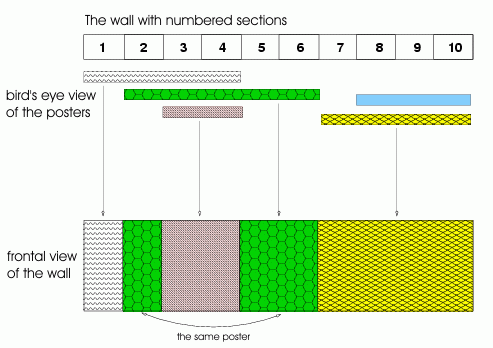POSTERS - Election Posters
A parliamentary election was being held in Byteland. Its enterprising and orderly citizens decided to limit the entire election campaign to a single dedicated wall, so as not to ruin the panorama with countless posters and billboards. Every politician was allowed to hang exactly one poster on the wall. All posters extend from top to bottom, but are hung at different points of the wall, and may be of different width. The wall is divided horizontally into sections, and a poster completely occupies two or more adjacent sections.
With time, some of the posters were covered (partially or completely) by those of other politicians. Knowing the location of all the posters and the order in which they were hung, determine how many posters have at least one visible section in the end.
Input
The input begins with the integer t, the number of test cases. Then t test cases follow.
Each test case begins with a line containing integer n - the number of posters (1 ≤ n ≤ 40000). Then n lines follow, the i-th (1 ≤ i ≤ n) containing exactly two integers li ri, denoting the numbers of the leftmost and rightmost sections covered by the i-th poster (1 ≤ li < ri ≤ 107). The input order corresponds to the order of hanging posters.
Output
For each test case output a line containing one integer - the number of posters with visible sections.
Example
Input: 1 5 1 4 2 6 8 10 3 4 7 10 Output: 4
An illustration of the sample input is given below.

hide comments
|
|
Haidar Abboud:
2013-05-22 11:34:30
Comment #1 : done using an O(N log N) algorithm. Can it be solved in O(N) ?
|
|
|
coding_express:
2013-05-18 21:19:51
more test cases please |
|
|
coding_express:
2013-05-18 21:19:05
please give some tricky test cases |
|
|
昌(尼莫):
2013-05-15 03:31:04
i am constantly getting WA but i tried various test cases and it seems to be working fine . So , if there are any good cases please help me |
|
|
saket diwakar:
2013-01-18 21:44:37
nice one.....:) Last edit: 2013-02-01 03:51:38 |
|
|
Paul Draper:
2012-11-20 04:36:17
A good test case that I failed on at first
|
|
|
Brian Bi:
2010-11-15 02:33:46
The judge is occasionally buggy in this way. If it bothers you that much, you can contact the problem setter and ask him to rejudge it... |
|
|
shivmitra mishra:
2010-07-30 21:16:36
there is an AC solution using 0.00 sec and 0k memory..hws that possible while other solutions have used memory like 2.0 M ???? |
| Added by: | adrian |
| Date: | 2004-07-19 |
| Time limit: | 7s |
| Source limit: | 50000B |
| Memory limit: | 1536MB |
| Cluster: | Cube (Intel G860) |
| Languages: | All |
| Resource: | VI Polish Collegiate Team Programming Contest (AMPPZ), 2001 |

 RSS
RSS